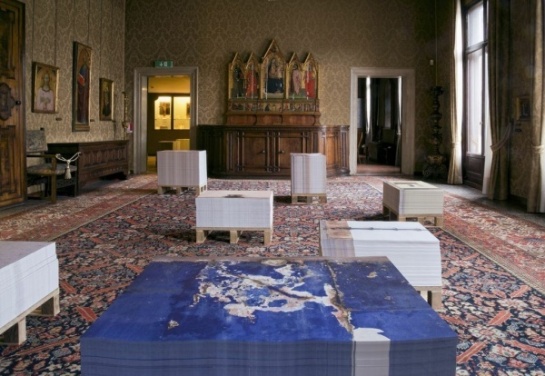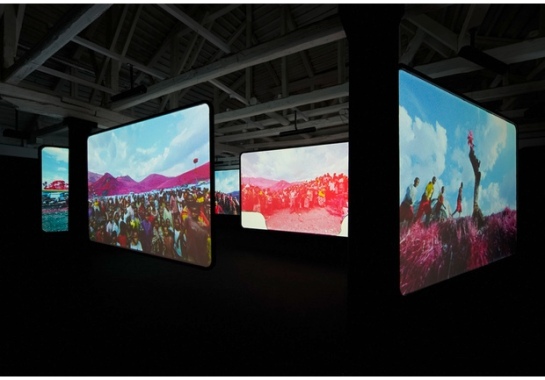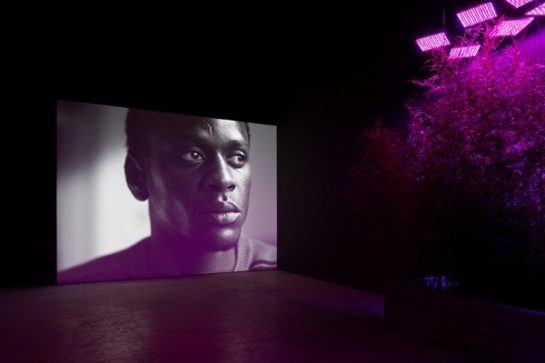Some Venice Highlights – the Pavilions (Angola, Ireland, Denmark)
Pavilion of Angola: Edson Chagas, ‘Luanda, The Encyclopedic City’
‘Lunanda, The Encyclopedic City’ plays on the title of the Biennale’s curated exhibition ‘The Encyclopedic Palace’, here Edson Chagas categorises Angola’s capital city Luanda through a series of photographic images which display scenes depicting a developing African city. Housed inside a museum setting, the Palazzo Cini, Chagas’s images have been mass printed and are displayed sculpturally as stacks of images on wooden pallets. The images themselves depict scenes of deterioration and poverty within the city, often containing a disguarded item such as a burst football, a mannequin bust or a broken chair.. the objects and scenes create an interesting juxtaposition to the surrounding museum displaying ornate, rich, historical artifacts. The audience are invited to takeaway the images, extending the idea of the ‘gallery space’ outside of an institution and the participation of the viewer in selecting work. Trying my best not to end of taking too much paper home with me from the Biennale (though I must have failed as returned with a few kilos!) making a selection of my favourite images to take home became a part of viewing the exhibition. The question is where all of these images will end up, on the walls of visitors homes and studios? Will they even make it on the journey home? Become untouched with a pile of other exhibition takeaways, end up in the bin or become disguarded somewhere just like the objects within the image?
Pavilion of Ireland, Richard Mosse, ‘The Enclave’
Collaborating with cinematographer Trevor Tweeton and sound artist Ben Frost, Richard Mosse has developed his photographic body of work ‘Infra’ which documents the war zone in the eastern Democratic Republic of Congo, into an all encompassing video installation ‘The Enclave’. The installation consists of multiple screens hanging throughout the space, to fully engage with the work and watch the world unfolding in the room, the viewer must walk through the space to view the screens which cannot be watched all at once from one position. In installing the screens in such a way the viewer becoming immersed in the work. And what a world one is being drawn into; the camera pans across beautiful rich pink landscapes and blue skies; at first seemingly paradise yet soon terrifyingly brutal and tragic. Circling the beautiful lush landscape I feel a foreboding sense of sadness and unease, perhaps heightened by the soundtrack, constructed from real on site sound recordings. The camera begins to follow a group of young boys, they start to run through the landscape towards home curiously looking back at the camera every so often, this direct engagement with the camera is powerful, drawing the viewer into the scene, we see through the camera’s eyes. Suddenly we realise we’re in the middle of the the war zone, in one scene we watch a mass of coffins being built and bodies ready for burial; at another point the screens turn to darkness for a moment and then the sound of gunshots, before returning to the pink landscape and the people. Rethinking traditional conflict photography ‘The Enclave’ is a powerful, unforgettable and important work.
Pavilion of Demark, Jesper Just, ‘Intercourses’
Jesper Just’s video installation ‘Intercourses’ comprises a multi-channel video installation, projected throughout the the spaces of pavilion. In the cinematic videos, which seem to be set in Paris, we watch the encounters of three men in the city. In one scene a man rides down a Parisian Street on a motorcycle, the camera follows the man, whist exploring the backdrop of the city. The videos themselves appear to be non-linear, an ongoing exploration of the city; the characters and their movements are intriguing yet they seem only to exist within the space, there is no narrative. Although the city has Parisian buildings, white facades, pretty balconies and offers glimpses in the distance of monuments such as the Eiffel Tower, we are also presented with a wasteland, and crumbling buildings on the edge of the city. Is this Paris? The pavilion itself too feels part of the outskirts of this city, with no apparently entrance or exit, the viewer slips into the space which feels almost as if it could be an abandoned building, inside bare brick walls and plants growing in a strange artificial pink light, we exit the installation through a workshop like room. This ‘Paris’ is in fact a suburb of Hangzhou, China where a replica of the French capital city has been constructed. The paradoxical nature of replicating of a place within a foreign place mimics the Biennale itself and the site of the Giardini which houses national pavilions representing a country within another country. In ‘Intercourses’ the site is the central subject of the installation the work explores a number of themes surrounding this; dislocation and duplication, and the experience of time, place in conjunction with memory, fact and fiction.


